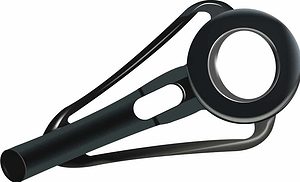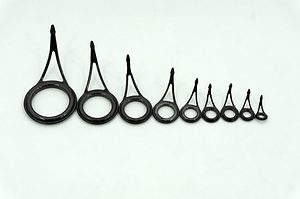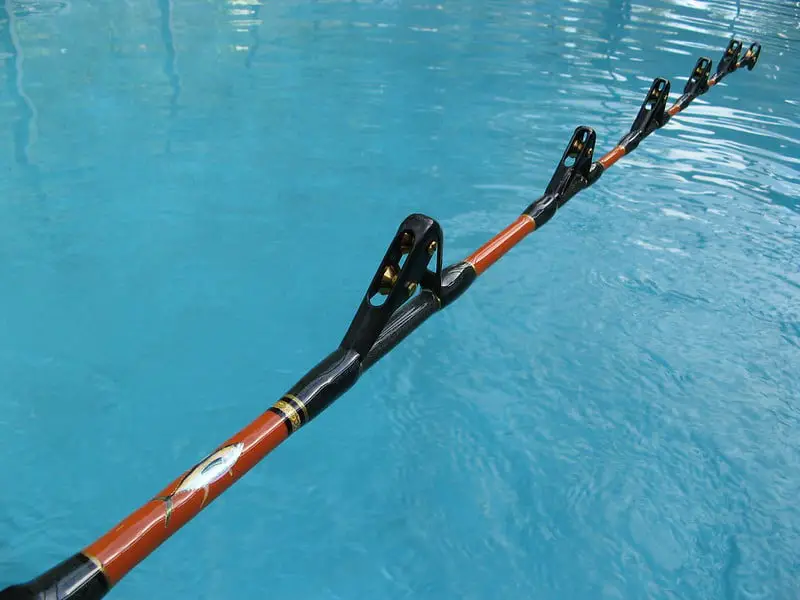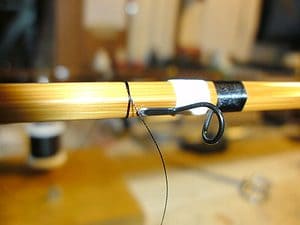Disclosure: Some posts contain affiliate links, which earn us a commission if you make a purchase through them. Positive Fishing © participates in various affiliate networks including the Amazon Services LLC Associates Program.
If you plan to start to build your own fishing rods from blanks or need to replace some guides on one of your existing rods, you’ll need to know a bit about rod guides and how they work.
Rod guides are an incredibly important part of a fishing rod as they guide the line while you’re casting, retrieving, and fighting fish. Having the wrong ones fitted on your rod can lead to issues in all these areas, so getting it right is important.
Join me as we look at everything you need to know about choosing guides for a fishing rod, from the styles, what are their function, and the sizes available.
What Is The Purpose Of Fishing Rod Guides?
Sometimes referred to as line guides, they direct your line where you want it to go when you cast the rod and wind your reel back in. You should think of them as the barrel of a gun, just on a fishing rod.
For the best results, they should be aligned straight; this allows the rod to load evenly on the cast for maximum casting distances, spread the pressure when playing a fish, and ensure your line goes on the reel correctly.
As you can see, they play a vital role in all types of fishing rods, whether they’re spinning rods, casting rods, trolling rods, or fly rods.
What Are The Different Types Of Rod Guides?
To make things more complicated than they should be, rod guides are interchanged with terms such as rod eyes, rod eyelets, line guides, roller guides, and rod rings!
There are two categories of guides across all fishing rod types:
1. Tip Top Guides

Tip top guides are the final guide that sits at the end of your rod and are made slightly differently from the main guides.
These come with a hollow tube section at their base, allowing you to slip the end of the rod blank into the hollow tube and then glue it down.
They are probably the most important guide on your rod as they provide your line with the final direction on the cast. They can also be called line guides, where the rod bends during a fight with a fish.
Types Of Rod Tip Tops
There are four main types of tip-top guides, which vary depending on the rod you use:
- Fly-tip tops for fly rods.
- Casting tip tops for spinning/casting rods.
- Boat tip tops for boat rods.
- Roller tip tops for big trolling rods.
Fly and boat tip tops are the more basic of the two, while casting tip tops are reinforced to handle the pressure of casting big lures, and trolling tip tops come with rollers to ensure zero line friction on the line when fighting giants like marlin.
The roller removes the friction that might otherwise burn the line during the fight and damage it to the point that you lose the fish or a fish in the future.
2. Main Rod Guides

the rod blank.
Main rod guides are the ones that run the length of your rod from above the reel seat to the guide before the tip-top. They are usually spaced in large increments at the butt section of the rod and are spaced closer together the nearer you get to the tip.
These guides do not have a hollow section that slots onto the rod, like a tip-top guide. Instead, they have feet wrapped with thread around the rod blank and sealed with epoxy. This is why you have little bumps in the rod blank around each guide, as it’s where the wrapping occurred.
Types Of Main Rod Guides
There are five types of rod guides you can put along the length of a rod blank; each one is quite different from the next.
You’ll notice the word foot being used, and it’s key to understand what it is before we move forward. The foot is the part of the guide placed onto the rod blank, which you then wrap around to fix your guide onto a rod.
1. Single foot guides
Single-foot have just one foot to wrap around the rod blank. They can be used on both fly and spinning/casting rods, but the single-foot design means they are prone to get bent if they are, for example, dropped or accidentally bumped.
2. Double foot guides
Double foot have two feet, one at each end, meaning you can wrap both feet when attaching them to the rod blank. This makes them much stronger than single-foot guides and far less prone to bending.
You will find these on fly and spinning rods, which are a better choice than the single-foot option due to their better durability.
3. Trolling guides
Trolling guides are a form of double foot guides, but they are built with reinforcements on their frame to ensure they can handle the larger species one catches when trolling.
4. Roller guides
Roller guides are also used on trolling rods but usually only on the rod intended for big game fishing. They can have single or double rollers built into them to ensure the minimum friction as the line leaves the reel at over 70 mph when hooked up to a billfish or tuna.
These double-foot styles are secured well to ensure they can handle the strength of huge pelagics.

5. Snake Guides
Snake guides are a form of double-foot guides that are used on fly rods only. They look a bit like a snake but are made from a single piece of shaped wire to form a guide with a foot at each end.
They are incredibly light and have minimal friction to maintain a fly rod’s action and casting performance.
What Are Inserts?
You will most likely have wondered when I would get onto the subject of inserts, as both single and double-foot guides come with them.
Inserts sit on the inside of the rod guide, and their purpose is to create the most frictionless surface so that your line can travel through without being damaged or slowed down as it passes through the rings when you cast. This enhances the smoothness of the rod’s casting performance and fish-fighting performance.
Inserts can be made from various materials, with ceramic being the most popular. Silicon Carbide (SiC), Nanolite, Alconite, NanoPlasma, and Torzite Inserts are the main ones. Each type has a different hardness value to suit the fishing rod use.
If you ever find a chipped insert, you need to change the rod guide out, as it will start to wear away your line.
How To Choose The Right Fishing Rod Guide?
When it comes to choosing guides, it will be in one of two scenarios – replacing a rod guide in an existing rod or adding rod guides to an empty blank you are building.
Who Makes The Best Rod Guides?
Fuji makes the best rod guides due to the quality, construction, and materials they use, and they are widely used on all the best fishing rods. Made from aluminum oxide, they are extremely hard, light, and durable.
Fuji makes several styles of guides – Hardloy, Alconite, Gold Cermet, and Silicone Carbide (SiC). Therefore, please check carefully which one you require; they are all for different uses and are equally high quality.
How To Replace Rod Guides?
Like all things in fishing, rod guides come in particular sizes to match rod blanks, and therefore, you will want to make sure you are picking the right rod guide to replace the broken or missing one.
The best way to get this right is to take your rod into a shop that sells guides and buy a matching rod guide for the replacement. Ensure it’s the same type as the other guides with a similar insert and the right size according to its position on the rod.
Picking Rod Guides For A Blank
The first step is choosing rod guides based on the application of the rod – spinning, trolling, or fly fishing. You should always pick the right ones to match the category of the rod.
Then, you need to choose a particular type and size of guide to match the rod size and your preferences. Take measurements of your rod blank to match the size of the rod guides available, and then pick the right type you want to use, using the descriptions above, and you’re good to go.
If unsure about this process, go to a tackle shop rod builder with your blank and run through it in person with them.
What Is A Guide Wrap?

Rod guides are secured and aligned on the rod blank using a thread wrap. The thread is wound around the guide and the blank to hold the guide in place and straight.
There are several different types of thread; usually, nylon or metallic thread is used and can be purchased in 100-yard spools in multiple colors to suit your blank color. One of the best in the market is ProWrap Nylon, which has a strong tensile strength to ensure it holds in place securely.
ProWrap metallic and metallic braids are typically only used for decorative uses such as underwraps, trim bands, and overwraps.
Fishing Rod Guide Size Chart
The sizes available are slightly different between various guide manufacturers. For example, the largest manufacturer of guides, Fuji, manufactures various sizes for each of the multiple styles they produce.
Therefore, it is best to check on the Fuji official website to ensure that you order the right guide sets for your specific rod and what the correct replacement guide is.
You can also check out this fuji.pdf guide for more detailed information on all the Fuji rod components available.
Rolling Out
Thanks for reading my article; I hope you enjoyed it. The world of rod guides can be confusing at first, but it’s actually very simple after a while. If you are unsure which guide you need, check with a pro fishing shop for help.
You can read more of my articles on fishing rods, covering the best-in-class fly, spinning, and saltwater options.
- Top Tips For Fishing With Feathers - January 15, 2025
- How To Fish For Flounders: Tips, Rigs, & Baits - March 27, 2024
- Fortis Wraps Fishing Sunglasses: The Affordable Option For Anglers - January 25, 2024

